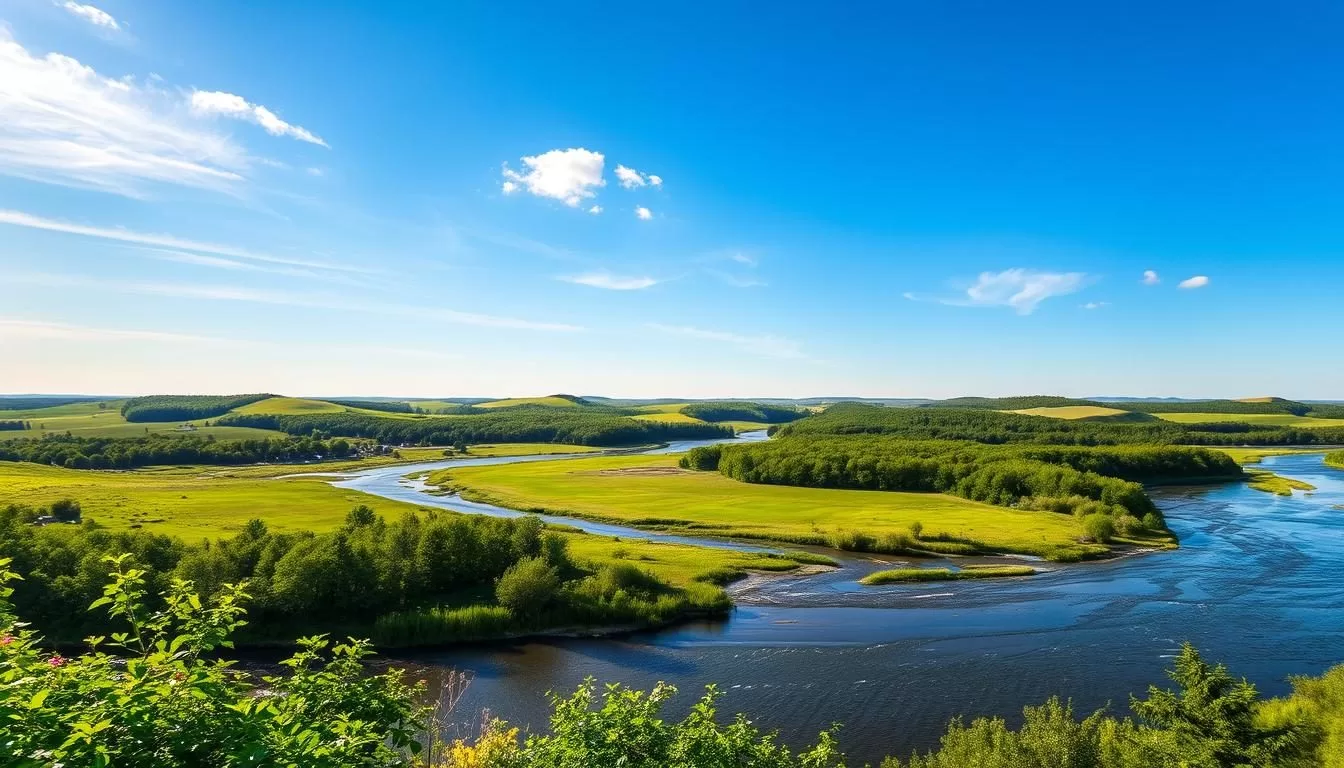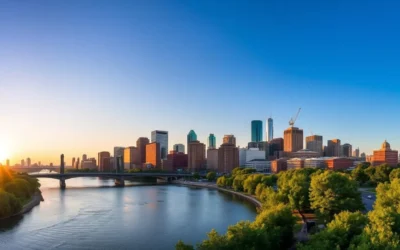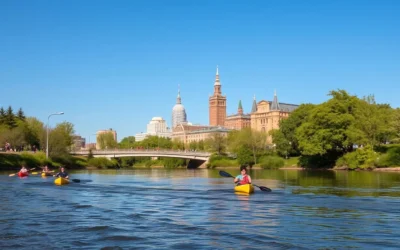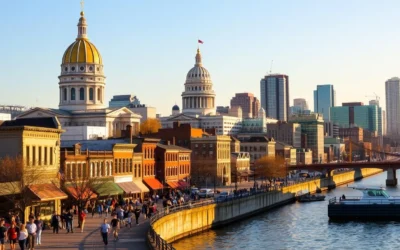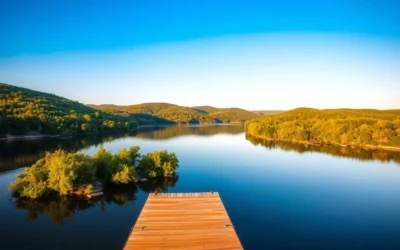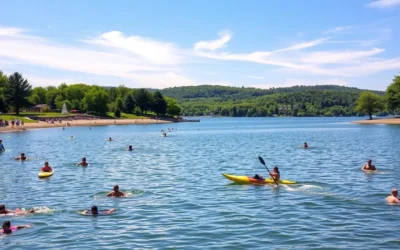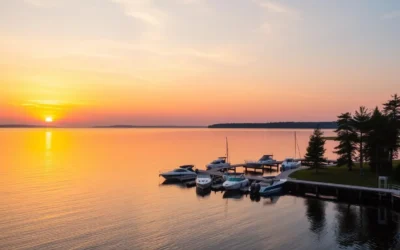Planning a trip to Minnesota requires more than just picking a destination; it demands a weather-savvy approach. The state’s dramatic seasonal changes make time a crucial factor in determining the success of your adventure.
The weather in Minnesota varies significantly throughout the year, with hot, humid summers and freezing, snowy winters. Late spring and early fall emerge as the ideal periods to visit, offering mild temperatures that are conducive to a variety of activities.
Understanding the best months to plan your weather-savvy trip to this northern state in the United States can make all the difference. By being informed, you can enjoy the beauty of Minnesota, from its scorching summer days to its bone-chilling winter nights, without being caught off guard.
Understanding Minnesota’s Distinct Seasons
Planning a trip to Minnesota requires understanding the state’s distinct seasons and their impact on your travel plans. Minnesota’s climate is characterized by significant seasonal variations, which can greatly affect the quality of your visit.
The Land of 10,000 Weather Changes
Minnesota is often referred to as the “Land of 10,000 Lakes,” but it’s also known for its rapidly changing weather. The state’s continental climate means it experiences a wide range of weather conditions, from cold winters to warm summers. Understanding these changes is key to making the most of your trip.
Why Weather Matters When Planning Your Minnesota Visit
The weather in Minnesota can significantly impact your travel plans, from the activities you can enjoy to the accessibility of various attractions. Certain activities are only available during specific times of the year, making the timing of your visit crucial. For instance, winter sports are best enjoyed between December and February, while summer is ideal for water activities.
| Season | Weather Conditions | Popular Activities |
|---|---|---|
| Winter | Cold, snowy | Skiing, ice fishing |
| Summer | Warm, humid | Swimming, boating |
| Spring | Mild, occasional rain | Hiking, birdwatching |
| Fall | Cool, foliage | Leaf peeping, hunting |
By understanding Minnesota’s distinct seasons and planning accordingly, you can ensure a more enjoyable and stress-free trip. Whether you’re looking to enjoy winter sports, summer lake activities, or the beauty of spring and fall, timing is everything.
Minnesota’s Climate at a Glance
To grasp Minnesota’s climate, it’s essential to examine the temperature extremes and precipitation patterns that define the state’s weather. Minnesota is known for its varied climate, with significant changes throughout the year.
Temperature Extremes: From Freezing to Sweltering
Minnesota’s temperature varies greatly, from freezing winters to sweltering summers. The state’s continental climate means you can experience harsh cold snaps and heatwaves. Understanding these temperature extremes is crucial for planning your visit.
Precipitation Patterns Throughout the Year
precipitation patterns in Minnesota vary significantly throughout the year. The wetter season, which lasts 5.8 months from April 10 to October 4, sees a greater than 25% chance of rainfall on any given day. June is the month with the most wet days, averaging 12.0 days with at least 0.04 inches of precipitation. The state’s average snowfall ranges between 40-70 inches annually, affecting winter travel.
The patterns of precipitation vary across different regions, with the western areas being relatively drier than the eastern portions. This variation impacts the state’s climate and weather conditions.
Winter in Minnesota: November to March
The winter season in Minnesota, which lasts from November to March, is a period of extreme cold and varied snowfall. During this time, the state transforms into a winter wonderland, with temperatures plummeting and snowfall varying across different regions.
Surviving the Brutal Cold
To survive the harsh Minnesota winter, you must be prepared for the extreme cold. The cold season, which lasts for 3.3 months, brings average temperatures that are quite low. By December, the average high temperature is 27°F, while the average low is 15°F. January is even colder, with an average high of 24°F and a low of 9°F. Dressing warmly is essential to withstand these temperatures.
You should also anticipate significant snowfall amounts during this period. The average snowfall varies across the state, with some areas receiving more snow than others.
Average Winter Temperatures and Snowfall
Minnesota’s winter temperatures are known for being harsh, with January being the coldest month. The average low temperature in January is around 10°F, while the average high is 24°F. The snowfall during this period is substantial, ranging from 40 inches in the southern regions to over 70 inches along the North Shore of Lake Superior.
- The cold season lasts from November 26 to March 4.
- January is typically the coldest month.
- Snowfall expectations vary across the state.
- Lake effect snow impacts areas near Lake Superior.
Winter Activities and Festivals
Minnesota’s winter season is a treasure trove of exciting activities and festivals that you won’t want to miss. As the snowflakes start to fall, the state transforms into a winter wonderland, offering a range of fun experiences.
Embracing the Snow: Outdoor Adventures
You can enjoy various outdoor activities like pond hockey and skiing. The City of Lakes Loppet is a fun winter sports festival to attend, showcasing the best of Minnesota’s winter sports culture.
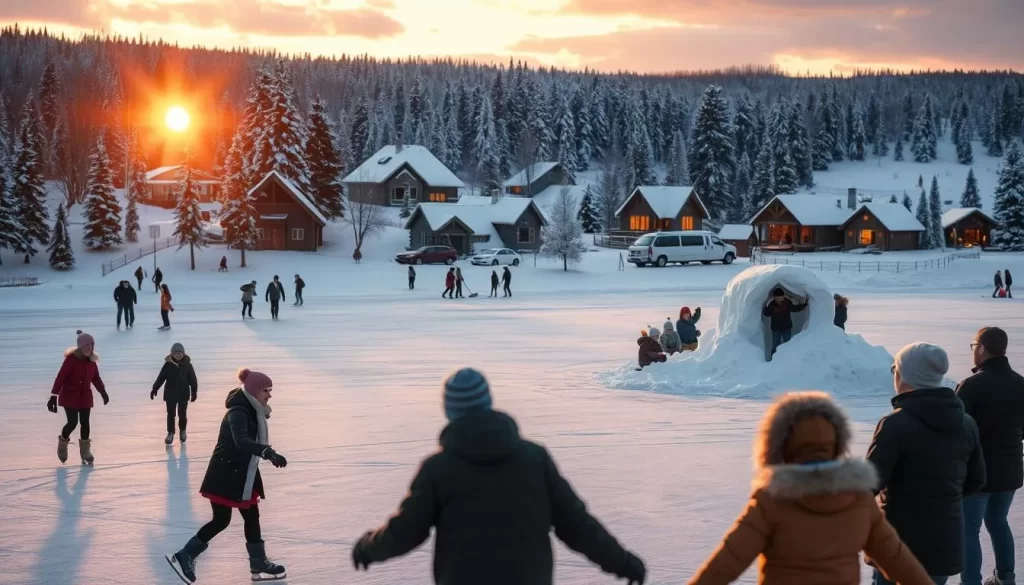
Winter Celebrations in the Twin Cities
The Twin Cities host some of the most iconic winter celebrations and festivals. You can visit the St. Paul Winter Carnival, one of the oldest winter festivals in the United States, featuring ice sculptures, parades, and winter sports competitions. Minneapolis’s Holidazzle transforms downtown into a winter wonderland with lights, markets, and seasonal entertainment.
| Event | Location | Description |
|---|---|---|
| St. Paul Winter Carnival | St. Paul | Ice sculptures, parades, and winter sports competitions |
| Holidazzle | Minneapolis | Winter wonderland with lights, markets, and seasonal entertainment |
| City of Lakes Loppet | Minneapolis | Winter sports festival featuring skiing and other activities |
Essential Winter Packing Guide
Minnesota’s winter weather demands careful planning and preparation to ensure a safe and enjoyable trip. When visiting Minneapolis in the winter, you’ll need to pack accordingly and be aware of the driving conditions.
Clothing Essentials for Sub-Zero Temperatures
Packing the right clothing is crucial for braving Minnesota’s sub-zero temperatures. You’ll need a heavy coat, insulated snow pants, warm hats, gloves, and scarves. Layering is key to maintaining body heat. Consider bringing thermal underwear, a warm fleece jacket, and waterproof boots to keep you warm and dry.
Winter Driving Tips and Precautions
If you plan to drive during your visit, it’s essential to be prepared for the harsh winter conditions. Slow down and be cautious of black ice hazards on unplowed roads. Familiarize yourself with Minneapolis’ snow removal rules to avoid having your car towed. To drive safely, begin and stop slowly to maintain control of your vehicle.
| Winter Driving Tips | Description |
|---|---|
| Maintain Greater Following Distances | Leave enough space between you and the vehicle in front to allow for stopping time |
| Gentle Braking | Avoid slamming on the brakes to prevent skidding on icy roads |
| Handle Skids | Know how to correct your vehicle’s skid to maintain control |
Spring in Minnesota: April to May
When spring arrives in Minnesota, be prepared for variable weather. The transition from winter to spring is not always straightforward, with temperatures often fluctuating between cold and mild.
The Slow Arrival of Spring Weather
Spring weather in Minnesota arrives slowly, with March typically remaining cold, sometimes below freezing. As April progresses, warmer days become more frequent, but the warmth is not consistent. It isn’t until May that the weather starts to feel more like summer, although occasional cool days can still occur.
The slow arrival of spring means that the weather can be quite unpredictable, with big temperature changes and even snow in late spring. This unpredictability can be challenging for visitors who are not prepared.
Navigating the Freeze-Thaw Cycles
One of the key characteristics of Minnesota’s spring is the freeze-thaw cycle. During this cycle, daytime temperatures rise above freezing, while nighttime temperatures dip below freezing. This cycle affects road conditions, creating challenges like potholes and occasional ice patches.
To navigate this cycle, you need to be prepared for variable road conditions and adjust your activities accordingly. For example, outdoor activities may need to be planned around the muddy trails that result from the thawing process.
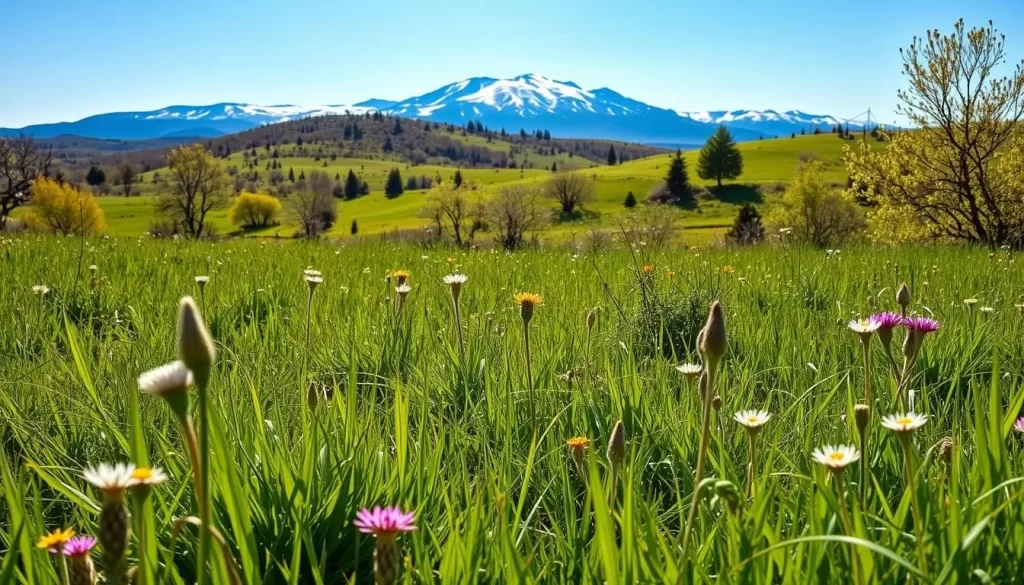
Spring Activities and Events
As spring unfolds in Minnesota, the state’s natural beauty comes alive with a variety of activities and events. The season brings a sense of renewal and rejuvenation, making it an ideal time to explore the outdoors and engage in various cultural activities.
Outdoor Opportunities as Nature Awakens
With the thawing of winter’s chill, Minnesota’s landscapes transform into vibrant settings for outdoor adventures. You can enjoy hiking, biking, or simply taking in the breathtaking views of the awakening nature. The transition from winter to spring is a great time to visit the numerous parks and trails, such as those found in the Minneapolis Chain of Lakes or Voyageurs National Park.
As the weather becomes more favorable, outdoor events and festivals start to take place. You’ll find a range of activities, from outdoor concerts to festivals celebrating spring, like the Minnesota Spring Festival.
Spring Packing Recommendations
To make the most of your spring visit to Minnesota, it’s essential to pack appropriately. Start with a light down jacket in March, transition to jeans and short sleeves in April, and add shorts and sandals in May. Don’t forget to include layers for the unpredictable weather, along with a light sweater, raincoat, and umbrella. The right spring packing list and suitable footwear will ensure you’re prepared for the transitional weather.
| Month | Clothing | Footwear |
|---|---|---|
| March | Light down jacket | Waterproof boots |
| April | Jeans, short sleeves | Waterproof shoes |
| May | Shorts, sandals, layers | Sandals, hiking boots |
Summer in Minnesota: June to August
Summer in Minnesota, spanning from June to August, brings with it a unique set of weather conditions. The state experiences a mix of warm temperatures and sudden storms, making it essential for visitors to be prepared.
Hot and Humid: Understanding Summer Weather Patterns
The summer season in Minnesota is characterized by hot and humid weather, with temperatures often reaching their peak in July. The warm air from the south brings moisture, leading to heatwaves and increased humidity. Understanding these patterns can help you plan your outdoor activities and stay comfortable.
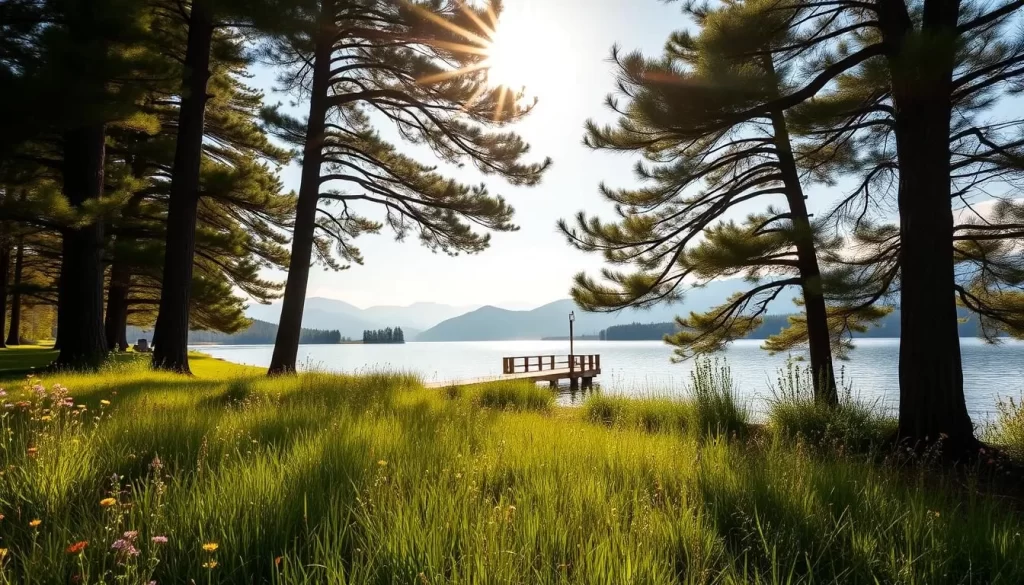
Dealing with Summer Storms and Mosquitoes
Minnesota’s summer is also marked by storms that bring much-needed rain to the region. These storms can be intense, with thunderstorms and heavy downpours. Additionally, the warm and moist air creates an ideal environment for mosquitoes. To protect yourself, it’s advisable to stock up on insect repellent and wear light, long clothing to prevent bites.
By being aware of these weather conditions and taking necessary precautions, you can enjoy Minnesota’s summer to the fullest. Whether you’re exploring the outdoors or attending local events, being prepared will make your experience more enjoyable.
Summer Activities and Festivals
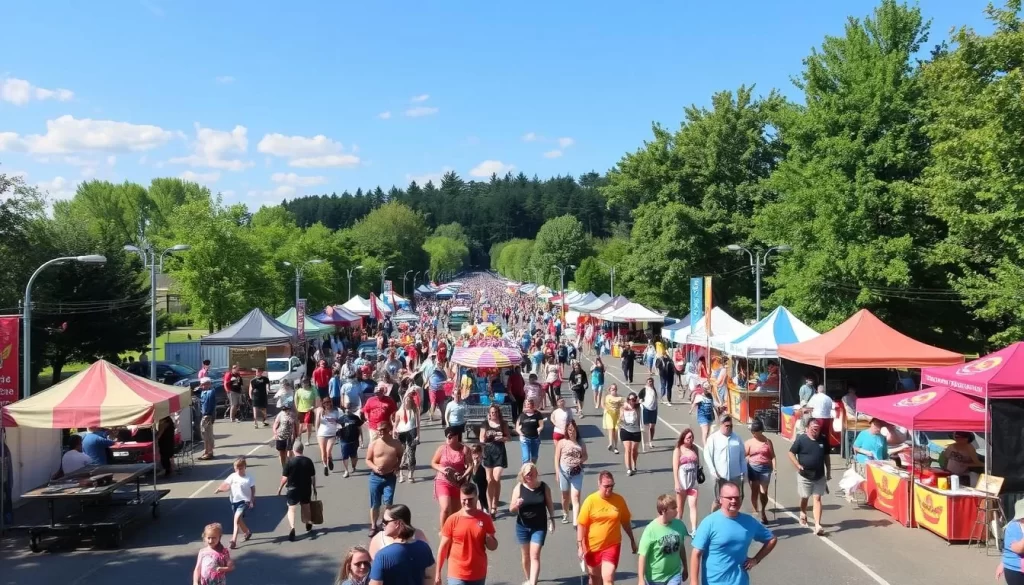
As the temperature rises, Minnesota transforms into a vibrant hub of summer festivals and events. The state offers a wide range of activities that cater to different interests and age groups.
The summer season in Minnesota is perfect for outdoor enthusiasts, with numerous lakes, parks, and trails to explore. You can enjoy water recreation on Minnesota’s lakes, such as swimming, kayaking, or paddleboarding.
Water Recreation on Minnesota’s Lakes
Minnesota’s lakes are a major attraction during the summer months. You can rent a boat or take a guided tour to explore the lakes and enjoy water activities like fishing or water skiing.
Summer Packing Essentials
When visiting Minnesota in the summer, it’s essential to pack light and breathable clothing that can keep you cool in the warm weather. Moisture-wicking fabrics, shorts, t-shirts, and loose dresses are some of the must-haves.
Don’t forget to pack sun protection like sunglasses, a hat, and sunscreen. A waterproof windbreaker or poncho is also a good idea, as summer thunderstorms are common in Minnesota.
In addition to clothing, other summer essentials include insect repellent, water bottles, and cooling towels. These will help you stay comfortable and protected during your outdoor adventures.
- You’ll learn about lightweight, breathable clothing options that work best for Minnesota’s warm and sometimes humid summer days.
- You’ll discover the importance of sun protection, including sunscreen, sunglasses, and hats for long days outdoors.
- You’ll understand why a light rain jacket or poncho is essential even during summer, as afternoon thunderstorms are common.
- You’ll get recommendations for footwear that works for various summer activities, from city exploration to hiking trails.
- You’ll learn about other summer essentials like insect repellent, water bottles, and cooling towels for particularly hot days.
Fall in Minnesota: September to October
As the humidity drops in mid-September, Minnesota welcomes the fall season with open arms, offering a perfect blend of outdoor activities and city exploration. The air becomes crisper, and the landscape transforms into a vibrant display of autumn colors.
Fall Colors and Cooling Temperatures
By early October, the trees turn gold and crimson, creating a picturesque scenery. The cooling temperatures make it an ideal time for outdoor pursuits like hiking and biking. You’ll find locals enjoying the season by jogging and playing in the leaves that decorate the ground.
The Brief but Beautiful Autumn Season
Despite its brevity, typically lasting from mid-September through October, Minnesotans often say fall is their favorite season. The season’s short duration makes it all the more special, with the landscape changing rapidly. Early November often brings the first snowfalls, marking the end of autumn.
- The special quality of light during Minnesota’s fall creates a golden glow across the landscape.
- Cooling temperatures and departing insects make fall ideal for outdoor activities.
- The harvest season in Minnesota’s agricultural areas contributes to the fall atmosphere.
Minnesota’s fall is a beautiful and brief season, making it a unique time to experience the state’s natural beauty.
Fall Activities and Events
Minnesota’s fall season is a treasure trove of experiences, from vibrant foliage tours to harvest festivals. The state’s natural beauty is on full display during this time, with the changing leaves creating a picturesque landscape.
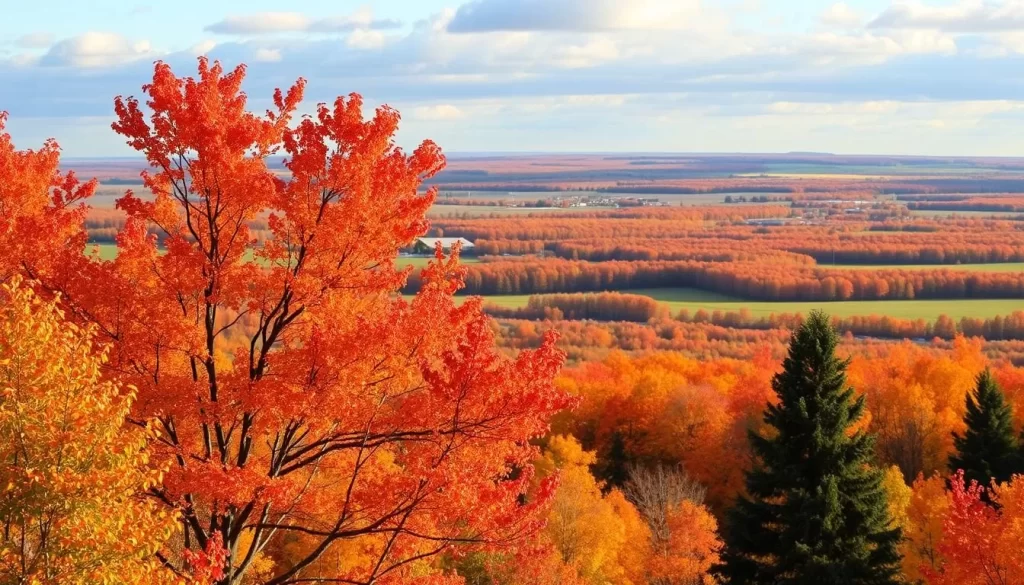
Ideal Autumn Wardrobe for Minnesota
When visiting Minnesota during the fall, it’s essential to pack layers for your wardrobe. The temperatures can fluctuate significantly, so having a mix of lightweight and warm clothing is crucial. You should include items like fleeces, jackets, and comfortable boots to ensure you’re prepared for the varying weather conditions.
Harvest Festivals and Seasonal Celebrations
Minnesota is known for its harvest festivals and seasonal celebrations, which reflect the state’s agricultural heritage. You can experience the Stillwater Harvest Fest, Oktoberfest celebrations, and Halloween activities throughout the state. These events offer a glimpse into the local culture and community traditions, with many featuring seasonal specialties like apple cider and pumpkin treats.
Minnesota, United States: Best Months for a Weather-Savvy Trip
When planning a trip to Minnesota, understanding the best months to visit can make all the difference in your experience. Minnesota’s climate is known for its extremes, with harsh winters and warm summers. The state’s weather patterns can significantly impact your travel plans, from outdoor activities to the comfort of your journey.
Late Spring (May): Perfect for Nature Lovers
In late spring, particularly May, Minnesota transforms into a vibrant landscape. The temperatures are mild, and the natural beauty of the state is on full display. It’s an ideal time for nature lovers to enjoy outdoor activities like hiking and birdwatching without the harsh conditions of winter or the crowds of summer.
Summer (June-August): Ideal for Lake Activities
Summer is peak tourist season in Minnesota, with June to August being the warmest months. The numerous lakes and water bodies make it an ideal destination for water activities like swimming, boating, and fishing. However, it’s also a time of higher humidity and occasional thunderstorms.
Early Fall (September): The Sweet Spot for Visitors
Early fall, especially September, is considered the sweet spot for visitors. The weather is generally comfortable, with warm days and cool nights. The fall color season begins in northern Minnesota by mid-September, making it a picturesque time to visit. The reduced humidity and fewer insects add to the comfort, making outdoor activities more enjoyable.
| Period | Weather Conditions | Activities |
|---|---|---|
| Late Spring (May) | Mild temperatures, blooming flora | Hiking, birdwatching |
| Summer (June-August) | Warm to hot, humid, occasional thunderstorms | Swimming, boating, fishing |
| Early Fall (September) | Comfortable temperatures, fall colors | Sightseeing, outdoor activities |

Monthly Weather Guide: Temperature, Rainfall, and Daylight
To make the most of your visit to Minnesota, it’s essential to grasp the state’s monthly weather guide. Understanding the temperature, rainfall, and daylight patterns throughout the year will help you plan a more enjoyable trip.
Winter Months: November through March
During the winter months, Minnesota experiences cold temperatures, with averages ranging from 14°F to 24°F (-10°C to -4°C). November to March sees significant snowfall, with up to 50 inches (127 cm) in some areas. Daylight hours are limited, with as few as 8 hours of daylight in December.
Spring Months: April through May
As spring arrives, temperatures gradually rise, with averages ranging from 40°F to 60°F (4°C to 15°C). April and May see a mix of rain and sunshine, with around 3 inches (76 mm) of rainfall. Daylight hours increase, reaching up to 15 hours by May.
Summer Months: June through August
70°F to 85°F (21°C to 30°C). June, July, and August are the wettest months, with around 4 inches (102 mm) of rainfall each. These months also enjoy the longest daylight hours, with up to 15 hours of sunlight in June and July. You’ll experience a progression of temperatures, from June’s pleasant warmth through July’s peak heat and into August’s gradual cooling. Afternoon thunderstorms are common, and humidity is typically high in July and early August.
By understanding these monthly weather patterns, you can better plan your activities and make the most of your visit to Minnesota.
Transportation Tips for Different Seasons
When planning your trip to Minnesota, understanding the transportation options during different seasons is crucial. Minnesota’s climate varies significantly throughout the year, impacting how you travel within the state.
Getting to and Around the Twin Cities
The Twin Cities, comprising Minneapolis and Saint Paul, offer a unique transportation system. A notable feature is the skyway system, which connects various buildings, allowing you to navigate downtown areas without exposure to extreme weather. This infrastructure is particularly beneficial during harsh winters, keeping you warm and toasty as you explore both cities.
- Utilize the skyway system to move between buildings without going outside.
- Stay updated with local weather forecasts to plan your travel accordingly.
Navigating Minnesota’s Weather-Related Travel Challenges
Minnesota’s weather can pose significant travel challenges, from snow emergencies in winter to road construction in summer. To navigate these challenges effectively, it’s essential to stay informed about weather conditions and transportation alerts. Monitoring forecasts and alerts can help you avoid weather-related travel disruptions.
- Be aware of blizzard and wind chill alerts during winter.
- Plan alternative transportation routes in case of unexpected weather changes.
Budget-Friendly Seasonal Itineraries
Discover the best of Minnesota across different seasons with our budget-friendly travel guides. Minnesota is a state that offers a wide range of experiences, from the frozen landscapes of winter to the lush beauty of spring and the warmth of summer. You can enjoy these experiences without breaking the bank by planning your trip around budget-friendly activities and accommodations.
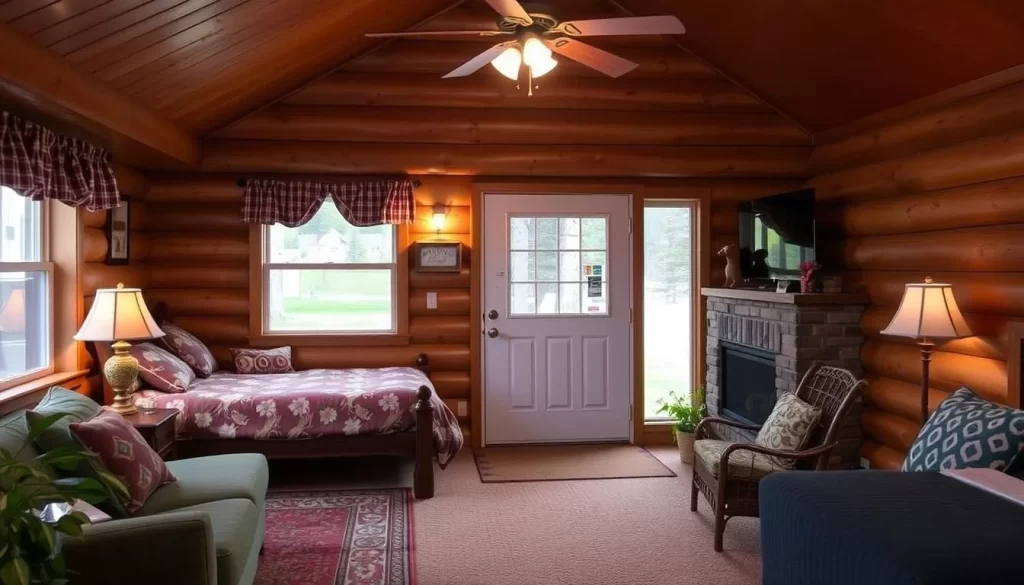
Winter Weekend Getaway
A winter weekend getaway in Minnesota can be both exhilarating and affordable. Enjoy ice fishing, sledding, or simply taking in the serene winter landscapes. For dining, consider affordable options like Punch Pizza for Neapolitan-style pies or The Weinery for hot dogs and burgers. When it comes to accommodations, look for budget-friendly hotels or vacation rentals that offer value for money.
Spring Nature Exploration
Spring is a beautiful time to explore Minnesota’s natural beauty as the snow melts and flowers bloom. Visit public parks and nature reserves, and take advantage of free or low-cost outdoor activities like hiking and bird watching. For a taste of different cultures, visit the Midtown Global Market, which offers affordable food from around the world.
Summer Lake Adventure
Summer is the perfect time for a lake adventure in Minnesota. Enjoy swimming, fishing, or paddling in one of the many lakes. Look for public beaches and lake access points, and consider renting affordable watercraft. For dining, pack a picnic and enjoy it at one of the many scenic spots, or try budget-friendly lakeside eateries.
Conclusion
With its dramatic seasonal changes, Minnesota offers a unique travel experience that requires some planning to fully enjoy. As you’ve learned, the state’s weather varies significantly throughout the year, from the brutal cold of winter to the sweltering heat of summer. By understanding these seasonal variations, you can choose the best time for your visit based on your preferences and activities.
You’ll now have a comprehensive understanding of how Minnesota’s seasons shape the visitor experience. This knowledge enables you to prepare for the weather, whether it’s packing for sub-zero temperatures or enjoying the lake activities in summer. You’ll be ready to plan a weather-savvy trip that maximizes enjoyment while minimizing weather-related challenges.
Minnesota’s diverse climate means there’s always something to enjoy, from winter sports to fall foliage. By embracing the state’s variable climate, you can have a memorable trip, regardless of the season. So, get ready for an ideal Minnesota getaway that fits your style and the weather.
The above is subject to change.
Check back often to TRAVEL.COM for the latest travel tips and deals.
Here are some Tours & Sightseeing suggestions that might pique your interests!
